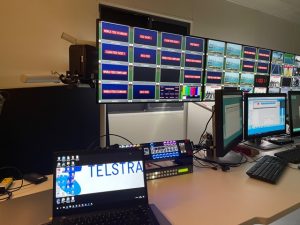Telstra Broadcast Services ready for America’s Cup Finals
The America’s Cup (AC36) may not feature any teams from the Americas (New Zealand squares off with Italy beginning this weekend) but it will feature plenty of broadcasters and long-distance transmission connectivity given its location in Auckland, NZ. Steven Dargham, head of Major Events at Telstra Broadcast Services, discussed the company’s efforts around the world feed distribution and more with SVG editorial director Ken Kerschbaumer.

Steven Dargham, Telstra Broadcast Services head of major events
How many rights holders, etc. are riding on the Telstra pipes?
Telstra distributed AC36’s world feed to over 60 global media and digital rights holders on its global fibre, internet and affiliated partner networks. Hundreds of countries will receive AC36 from broadcasters with rights in multiple regions.
Any sense of how many circuits and total bandwidth will be used?
To accommodate large bandwidth acquisition, Telstra deployed dual 10GigE over diverse dark fibre backbone from AC36’s International Broadcast Centre to dual Telstra Global Media Network PoPs in Auckland. The feeds then travel across the Tasman to Telstra’s Broadcast Operations Centre in Sydney, Australia, which acts as the centralised global distribution hub to right holding broadcasters. The aggregated content is then delivered over the internet for streaming and on subsea cables with protected capacity of up to 5Gig.
Everyone’s needs are different. How is your team meeting some of the different demands?
AC36 is one of our most recent exciting projects and is different compared to our delivery of the 2010 Americas Cup from Valencia, Spain. This year we had to build a flexible network solution to accommodate COVID impacts, such as a remote production model, advanced multi-service media edge equipment, Ethernet data services and high-speed internet services, as well as reduced on-site engineers. A range of high-quality media-edge hardware was deployed to support H.264 encoding, RTMP, Zixi and SRT, J2K and remote production capable equipment. The multi-service edge equipment backhauled all contents to the Telstra Broadcast Operations Centre (Telstra BOC) in Sydney where the centralised booking, monitoring and distribution to global media and digital rights holders took place.

Telstra has a two-person team on hand in Auckland for the America’s Cup.
How many people are on site from Telstra?
The initial plan was to have six operations and engineering staff in Auckland. Instead we have two onsite staff at the International Broadcast Center in Auckland, 24×7 live operations support and AC36 booking staff at the Telstra Broadcast Operations Centre in Sydney, and the remainder of our operations and engineering support in Paris and London.
What has been the biggest challenge working this event compared to others?
It’s no secret COVID created new challenges for live sporting events, however at the same time it created new opportunities for delivering large events. In the past broadcasters were reluctant to adopt new delivery models. The challenge of having minimal on-site engineers was overcome with the trust in the engineers and our global remote production, fibre and internet delivery models. Proven hybrid delivery models make broadcasters open to flexible delivery solutions that incorporate new technology.
Does Telstra have a major presence naturally in New Zealand or is it smaller connectivity that heads up to a larger hub in Sydney?
Telstra has an established presence in New Zealand with an agile operating model with local telecommunications providers. Telstra has key points of presence on its Global Media Network to service multinationals with content from New Zealand and Pacific Islands.

